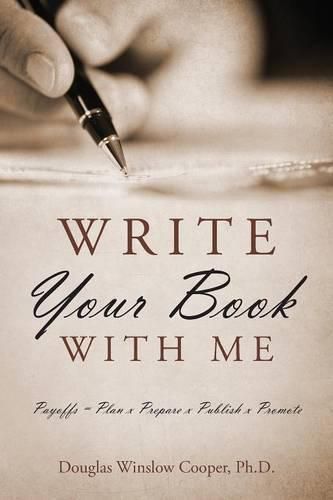Readings Newsletter
Become a Readings Member to make your shopping experience even easier.
Sign in or sign up for free!
You’re not far away from qualifying for FREE standard shipping within Australia
You’ve qualified for FREE standard shipping within Australia
The cart is loading…






This title is printed to order. This book may have been self-published. If so, we cannot guarantee the quality of the content. In the main most books will have gone through the editing process however some may not. We therefore suggest that you be aware of this before ordering this book. If in doubt check either the author or publisher’s details as we are unable to accept any returns unless they are faulty. Please contact us if you have any questions.
Most adults hope to write a book. Why not do so before it is too late? The author, a retired scientist who has published over 100 articles and has authored, co-authored, or edited a half-dozen books, tells the would-be author how to plan, prepare, publish, promote, and reap the pay-offs from writing a book, fiction or non-fiction. PLAN: determine your goals. Why are you writing? For self-satisfaction? For family, friends, and acquaintances? For the mass market? Your choice will influence how you go about publishing: printing, self-publishing, or using an indie, subsidy, or traditional publishing house. Writing for a large audience requires thinking about demographics: who is your ideal reader? Age, gender, location, race, ethnicity, income, politics, ethnicity, marital status…all count. PREPARE: book writing tips are given, from a constellation of authors. Nonfiction, approximately the truth, requires a degree of research that fiction, not necessarily the truth, will not, although historical fiction will need to take place in a real time and place. Your nonfiction title needs to be short, descriptive, possibly a bit puzzling, clarified by your subtitle. Your fiction title needs to evoke curiosity while signaling the genre of the book, as readers rarely buy books in genres other than their favorites. More advice is given on title, cover, dedication, table of contents, acknowledgment, foreword, and preface…what’s up front counts. Find time and space, then sit, think, write, perhaps open a vein. Heed the guidelines from ELEMENTS OF STYLE. Dr. Cooper describes the basics of the most popular types of nonfiction and fiction books. PUBLISH: computer manuscript preparation and print-on-demand technology have revolutionized publishing. A million new titles per year can reach the marketplace, ten times what was typical a decade or so ago. Authors can print their own books, work with an independent ( indie ) publisher, pay a subsidy or vanity press, or tr
$9.00 standard shipping within Australia
FREE standard shipping within Australia for orders over $100.00
Express & International shipping calculated at checkout
This title is printed to order. This book may have been self-published. If so, we cannot guarantee the quality of the content. In the main most books will have gone through the editing process however some may not. We therefore suggest that you be aware of this before ordering this book. If in doubt check either the author or publisher’s details as we are unable to accept any returns unless they are faulty. Please contact us if you have any questions.
Most adults hope to write a book. Why not do so before it is too late? The author, a retired scientist who has published over 100 articles and has authored, co-authored, or edited a half-dozen books, tells the would-be author how to plan, prepare, publish, promote, and reap the pay-offs from writing a book, fiction or non-fiction. PLAN: determine your goals. Why are you writing? For self-satisfaction? For family, friends, and acquaintances? For the mass market? Your choice will influence how you go about publishing: printing, self-publishing, or using an indie, subsidy, or traditional publishing house. Writing for a large audience requires thinking about demographics: who is your ideal reader? Age, gender, location, race, ethnicity, income, politics, ethnicity, marital status…all count. PREPARE: book writing tips are given, from a constellation of authors. Nonfiction, approximately the truth, requires a degree of research that fiction, not necessarily the truth, will not, although historical fiction will need to take place in a real time and place. Your nonfiction title needs to be short, descriptive, possibly a bit puzzling, clarified by your subtitle. Your fiction title needs to evoke curiosity while signaling the genre of the book, as readers rarely buy books in genres other than their favorites. More advice is given on title, cover, dedication, table of contents, acknowledgment, foreword, and preface…what’s up front counts. Find time and space, then sit, think, write, perhaps open a vein. Heed the guidelines from ELEMENTS OF STYLE. Dr. Cooper describes the basics of the most popular types of nonfiction and fiction books. PUBLISH: computer manuscript preparation and print-on-demand technology have revolutionized publishing. A million new titles per year can reach the marketplace, ten times what was typical a decade or so ago. Authors can print their own books, work with an independent ( indie ) publisher, pay a subsidy or vanity press, or tr